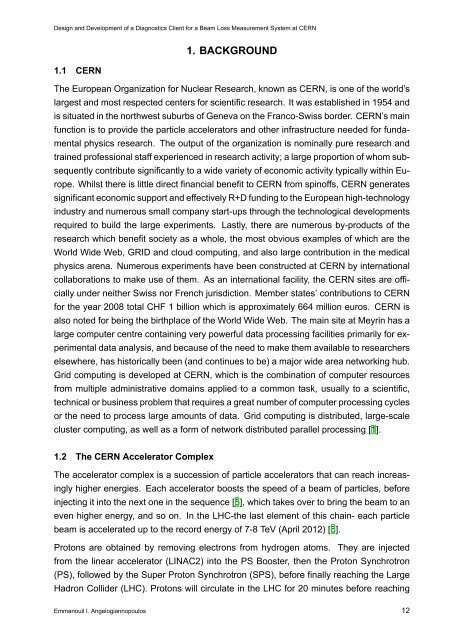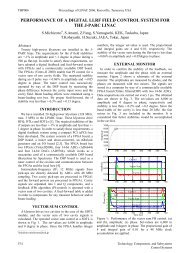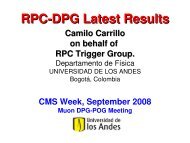Design and Development of a Diagnostics Client for a Beam Loss ...
Design and Development of a Diagnostics Client for a Beam Loss ...
Design and Development of a Diagnostics Client for a Beam Loss ...
Create successful ePaper yourself
Turn your PDF publications into a flip-book with our unique Google optimized e-Paper software.
<strong>Design</strong> <strong>and</strong> <strong>Development</strong> <strong>of</strong> a <strong>Diagnostics</strong> <strong>Client</strong> <strong>for</strong> a <strong>Beam</strong> <strong>Loss</strong> Measurement System at CERN<br />
1.1 CERN<br />
1. BACKGROUND<br />
The European Organization <strong>for</strong> Nuclear Research, known as CERN, is one <strong>of</strong> the world’s<br />
largest <strong>and</strong> most respected centers <strong>for</strong> scientific research. It was established in 1954 <strong>and</strong><br />
is situated in the northwest suburbs <strong>of</strong> Geneva on the Franco-Swiss border. CERN’s main<br />
function is to provide the particle accelerators <strong>and</strong> other infrastructure needed <strong>for</strong> funda-<br />
mental physics research. The output <strong>of</strong> the organization is nominally pure research <strong>and</strong><br />
trained pr<strong>of</strong>essional staff experienced in research activity; a large proportion <strong>of</strong> whom sub-<br />
sequently contribute significantly to a wide variety <strong>of</strong> economic activity typically within Eu-<br />
rope. Whilst there is little direct financial benefit to CERN from spin<strong>of</strong>fs, CERN generates<br />
significant economic support <strong>and</strong> effectively R+D funding to the European high-technology<br />
industry <strong>and</strong> numerous small company start-ups through the technological developments<br />
required to build the large experiments. Lastly, there are numerous by-products <strong>of</strong> the<br />
research which benefit society as a whole, the most obvious examples <strong>of</strong> which are the<br />
World Wide Web, GRID <strong>and</strong> cloud computing, <strong>and</strong> also large contribution in the medical<br />
physics arena. Numerous experiments have been constructed at CERN by international<br />
collaborations to make use <strong>of</strong> them. As an international facility, the CERN sites are <strong>of</strong>fi-<br />
cially under neither Swiss nor French jurisdiction. Member states’ contributions to CERN<br />
<strong>for</strong> the year 2008 total CHF 1 billion which is approximately 664 million euros. CERN is<br />
also noted <strong>for</strong> being the birthplace <strong>of</strong> the World Wide Web. The main site at Meyrin has a<br />
large computer centre containing very powerful data processing facilities primarily <strong>for</strong> ex-<br />
perimental data analysis, <strong>and</strong> because <strong>of</strong> the need to make them available to researchers<br />
elsewhere, has historically been (<strong>and</strong> continues to be) a major wide area networking hub.<br />
Grid computing is developed at CERN, which is the combination <strong>of</strong> computer resources<br />
from multiple administrative domains applied to a common task, usually to a scientific,<br />
technical or business problem that requires a great number <strong>of</strong> computer processing cycles<br />
or the need to process large amounts <strong>of</strong> data. Grid computing is distributed, large-scale<br />
cluster computing, as well as a <strong>for</strong>m <strong>of</strong> network distributed parallel processing [1].<br />
1.2 The CERN Accelerator Complex<br />
The accelerator complex is a succession <strong>of</strong> particle accelerators that can reach increas-<br />
ingly higher energies. Each accelerator boosts the speed <strong>of</strong> a beam <strong>of</strong> particles, be<strong>for</strong>e<br />
injecting it into the next one in the sequence [5], which takes over to bring the beam to an<br />
even higher energy, <strong>and</strong> so on. In the LHC-the last element <strong>of</strong> this chain- each particle<br />
beam is accelerated up to the record energy <strong>of</strong> 7-8 TeV (April 2012) [6].<br />
Protons are obtained by removing electrons from hydrogen atoms. They are injected<br />
from the linear accelerator (LINAC2) into the PS Booster, then the Proton Synchrotron<br />
(PS), followed by the Super Proton Synchrotron (SPS), be<strong>for</strong>e finally reaching the Large<br />
Hadron Collider (LHC). Protons will circulate in the LHC <strong>for</strong> 20 minutes be<strong>for</strong>e reaching<br />
Emmanouil I. Angelogiannopoulos 12















